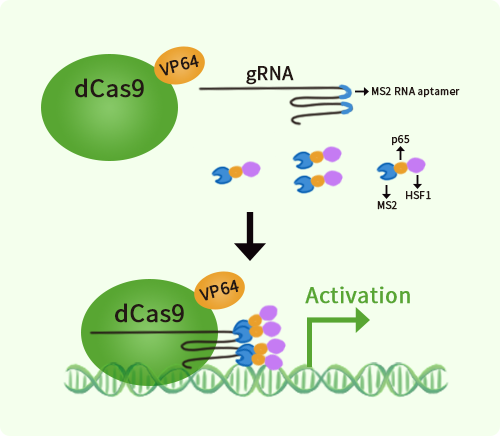Human alpha A Crystallin (CRYAA) activation kit by CRISPRa
CAT#: GA100991
CRYAA CRISPRa kit - CRISPR gene activation of human crystallin alpha A
Find the corresponding CRISPRi Inhibitor Kit
USD 1,290.00
2 Weeks*
Specifications
| Product Data | |
| Format | 3gRNAs, 1 scramble ctrl and 1 enhancer vector |
| Symbol | CRYAA |
| Locus ID | 1409 |
| Kit Components | GA100991G1, alpha A Crystallin gRNA vector 1 in pCas-Guide-GFP-CRISPRa GA100991G2, alpha A Crystallin gRNA vector 2 in pCas-Guide-GFP-CRISPRa GA100991G3, alpha A Crystallin gRNA vector 3 in pCas-Guide-GFP-CRISPRa 1 CRISPRa-Enhancer vector, SKU GE100056 1 CRISPRa scramble vector, SKU GE100077 |
| Disclaimer | The kit is designed based on the best knowledge of CRISPa SAM technology. The efficiency of the activation can be affected by many factors, including nucleosome occupancy status, chromatin structure and the gene expression level of the target, etc. |
| Reference Data | |
| RefSeq | NM_000394, NM_001363766 |
| Synonyms | CRYA1; CTRCT9; HSPB4 |
| Summary | 'Mammalian lens crystallins are divided into alpha, beta, and gamma families. Alpha crystallins are composed of two gene products: alpha-A and alpha-B, for acidic and basic, respectively. Alpha crystallins can be induced by heat shock and are members of the small heat shock protein (HSP20) family. They act as molecular chaperones although they do not renature proteins and release them in the fashion of a true chaperone; instead they hold them in large soluble aggregates. Post-translational modifications decrease the ability to chaperone. These heterogeneous aggregates consist of 30-40 subunits; the alpha-A and alpha-B subunits have a 3:1 ratio, respectively. Two additional functions of alpha crystallins are an autokinase activity and participation in the intracellular architecture. The encoded protein has been identified as a moonlighting protein based on its ability to perform mechanistically distinct functions. Alpha-A and alpha-B gene products are differentially expressed; alpha-A is preferentially restricted to the lens and alpha-B is expressed widely in many tissues and organs. Defects in this gene cause autosomal dominant congenital cataract (ADCC). [provided by RefSeq, Jan 2014]' |
Documents
| Product Manuals |
| FAQs |
Resources
Other Versions
| SKU | Description | Size | Price |
|---|---|---|---|
| KN216946 | CRYAA - human gene knockout kit via CRISPR, HDR mediated |
USD 1,290.00 |
|
| KN216946BN | CRYAA - human gene knockout kit via CRISPR, HDR mediated |
USD 1,290.00 |
|
| KN216946LP | CRYAA - human gene knockout kit via CRISPR, HDR mediated |
USD 1,290.00 |
|
| KN216946RB | CRYAA - human gene knockout kit via CRISPR, HDR mediated |
USD 1,290.00 |
|
| KN416946 | CRYAA - KN2.0, Human gene knockout kit via CRISPR, non-homology mediated. |
USD 1,290.00 |
{0} Product Review(s)
Be the first one to submit a review






























































































































































































































































 Germany
Germany
 Japan
Japan
 United Kingdom
United Kingdom
 China
China
